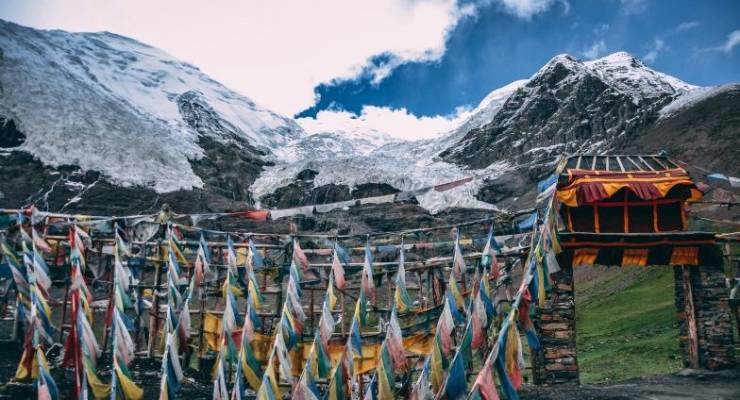
60 years ago, on March 10, there was a failed Tibetan uprising against the region’s Chinese Communist Party masters. It was this event that saw the Dalai Lama and other senior Tibetan leaders flee into what has since become permanent exile in India. Even so many years later, the impact is still felt.
“Tibet belongs to Tibetans,” said Lobsang Sangay at a rally in Dharamshala, India yesterday. Sangay is Tibet’s Sikyong, the official title of the President of the Central Tibetan Administration. The administration, otherwise known as the Tibetan Government in exile, has its headquarters at Dharamshala.
“Sixty years of the occupation of Tibet and the repression of Tibetans is too long,” he said.
In the decades since the uprising, the CCP has set about systematically eviscerating Tibetan culture, destroying temples and historical relics, and imprisoning monks.
At the same time, an aggressive internal migration program has been pursued, bringing millions of Han Chinese (who, as of the 2010 census, make up approximately 91.51% of China’s population) to Tibet. The process has become known as the “Hanification” of the region, creating a blueprint for other provinces that were originally previously majority-occupied by ethnic minorities — notably the Mongolians of Inner Mongolia and the Uighurs of Xinjiang.
Tibet was hit particularly hard during the Cultural Revolution. All religious and cultural activities such as chanting scriptures and lighting yak-butter lamps were banned. Tens of thousands of monks were forced to secularize, marry, or were sent to labour camps — and the destruction of religious buildings was escalated as artifacts were destroyed as well shipped out of Tibet for sale elsewhere.
The CCP has forcibly resettled Tibetans into designated areas, it has restricted the use and teaching of the Tibetan language, strictly monitored all monasteries, and forcibly promotes “patriotic education”.
In response, there is a long history of Tibetans from a wide cross section of ages and walks of life resorting to a campaign of self-immolation as a form of protest.
Unsurprisingly, a very different story is being told to the Chinese people, and indeed to the world, by the Chinese Communist Party. It is one where the CCP liberated the people of Tibet, and apparently “sixty years since the epoch-making democratic reform in Tibet, people in the plateau region have enjoyed unprecedented human rights”.
Still, what is true is that the Chinese abolished slavery, serfdom and unfair taxes when it annexed Tibet in 1949. They built Tibet’s first hospitals and opened schools in every major village as well as bringing clean water. The average life expectancy in Tibet has almost doubled since 1950 (to the age of 60). But there has been a price.
“Tibet is more open than ever. As a world-renowned tourist destination, Tibet received more than 30 million tourists in 2018. Any foreigners who wish to visit Tibet can apply through normal channels, and a large number of foreigners visit Tibet each year,” state run Xinhua News Agency announced triumphantly.
The reality is quite the reverse. Ordinary travelers must obtain special permits to travel to Tibet. Western Academics, diplomats and human rights groups are regularly denied access to the region — and western journalists have traditionally had great difficulty gaining access.
For a long time the anniversary has served as a rally date for anti-Beijing protests, perhaps most notably in 1989 as the pro-democracy movement began sweeping China’s intelligentsia and universities. In 2008 — the year of the Beijing Olympics — Tibetan activists used the occasion to draw attention to the plight of their people.
Now the date is treated with particular paranoia even by the CCP’s rather heroic standards. Each year the region is shuttered to foreigners across the period. This year, that period will be twice as long as usual, beginning mid February and running until April 1.
The reason for this, the propaganda machine has said, is due to the altitude.
Around the world Tibetan exiles and supporters, including in cities across Australia, marched to commemorate the anniversary. Democratic countries have marked the occasion by taking China to task on its appalling record in Tibet and to remind the world of the scale of repression of which Beijing is capable.
In recent days there have been reports of “re-education camps” built in Xinjiang for the “mass incarceration of the Uighur population”.
US House of Representatives Speaker Nancy Pelosi recently summed up the West’s view, saying, “60 years ago, the people of Tibet rose up against the Chinese government’s systemic repression and brutal attacks to defend their lives and liberty”.
“Each March 10th, we remember their bravery and determined spirit of those who fought and gave their lives, and we recommit to securing the promise of human rights and religious freedom for the people of Tibet,” Pelosi said.
While Australia did remonstrate with China over its treatment of Tibetans in its submission to the UNCHR’s latest regular review on China, as of the time of writing there had been deafening silence from Canberra on the anniversary. Instead, on Mar 7 it launched a campaign to get even more Chinese tourists to Australia — underscoring the triumph of trade over human rights.
On Tibet and its other human rights abuses, Beijing has Canberra pretty much where it wants it.








“the Chinese abolished slavery, serfdom and unfair taxes when it annexed Tibet in 1949. They built Tibet’s first hospitals and opened schools in every major village as well as bringing clean water. The average life expectancy in Tibet has almost doubled since 1950…” – How dare they!
Australia turns a blind eye to many things – we turned a blind eye to East Timor for years until it became so obvious that it would cause revulsion if no action was taken , then we let the Portuguese carpetbaggers back in to further muddy Timors chances of recovery.
We have turned a blind eye and will continue to turn a blind eye to West Papua the western half of New Guinea occupied by the Indonesians inhabited by peoples more akin to Papua New Guinea ethnic groups.
So pity about the Tibetans – let India Pakistan worry about them – Let us think about our neighbours close to us. Maps in Indonesia label Australia as South Irian – we have our local problems to solve .
“Maps in Indonesia label Australia as South Irian”
Can you give us some evidence of that?
Perhaps one day Australia will find itself faced with a parliamentary delegation from Indonesia, possibly including MPs from Papua, wanting to investigate the living conditions of Aboriginal people in Northern Australia. No doubt they will be impressed.
If the Han chinese packed up and left tomorrow, what would happen to Tibet? I’d bet it’d become a sad and sick Disneyland, probably with an attached friendly US forward strike airbase. I think they need to articulate a vision of what they might become (they might even have one). Navel gazing on their current situation falls on deaf ears if their target audience does the same to other cultures and countries.